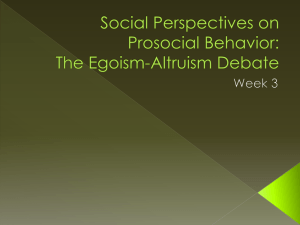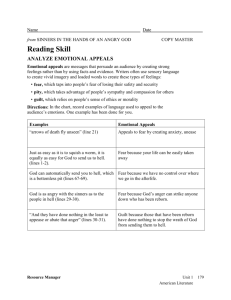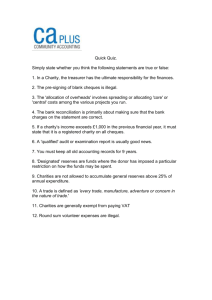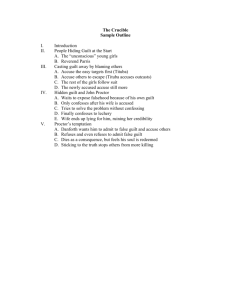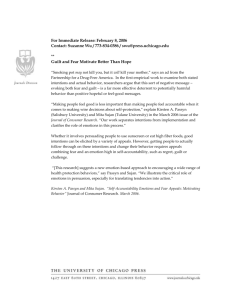The Role of Negative Emotions and Resistance Reducing Strategies
advertisement
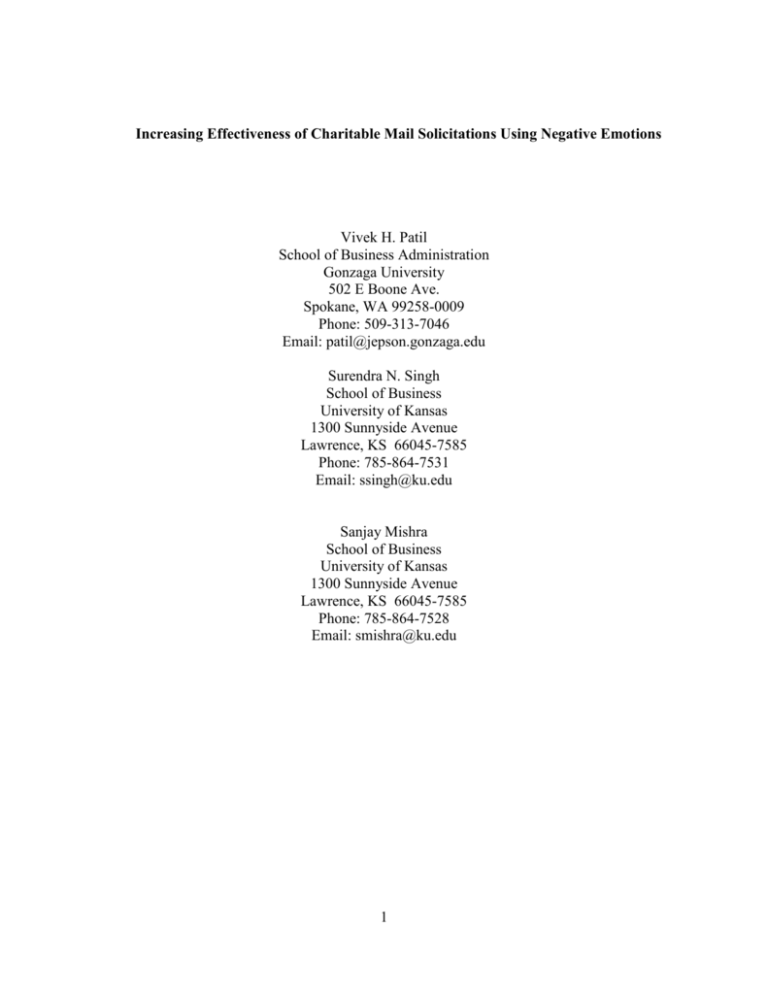
Increasing Effectiveness of Charitable Mail Solicitations Using Negative Emotions Vivek H. Patil School of Business Administration Gonzaga University 502 E Boone Ave. Spokane, WA 99258-0009 Phone: 509-313-7046 Email: patil@jepson.gonzaga.edu Surendra N. Singh School of Business University of Kansas 1300 Sunnyside Avenue Lawrence, KS 66045-7585 Phone: 785-864-7531 Email: ssingh@ku.edu Sanjay Mishra School of Business University of Kansas 1300 Sunnyside Avenue Lawrence, KS 66045-7585 Phone: 785-864-7528 Email: smishra@ku.edu 1 Extended Abstract Purpose In 2006, U.S. households received over 700 million mail requests for donations and donated over $295 billion (Giving USA 2007; Household Dairy Study 2006). As a result of the ever increasing needs for funds for charities, not only in the US but across globe, there is a need to increase the effectiveness of mail appeals from charities. Since the use of emotions in appeals for mail solicitations is common, we explore how two frequently used negative emotions, guilt and empathy (Batson 1991; Coulter and Pinto 1995) can increase the effectiveness of mail appeals. Specifically, we attempt to answer two key questions. First, what motivates people to donate when they are exposed to guilt─ or empathy─ inducing mail appeals? Second, are the two emotions appropriate for all solicitations, independent of the involvement of the potential donor with the charity? Theoretical Background Appraisal theories (e.g., Lazarus 1991) suggest that emotions are motivational responses to appraisals of environmental stimuli, which lead to behaviors deemed suitable to cope with these stimuli (Brehm 1999). Guilt has been defined as a negative, moral, and self-referential emotion, which involves an internal attribution about a negative outcome of a particular task (Tangney and Dearing 2002). Empathy involves the ability to take the perspective of others, such that generated feelings are focused on others and not on self (Batson 1991). In the context of nonprofit mail solicitations inducing empathy, since the state of a beneficiary is negative (for example, a disabled person in need of assistance), we classify empathy as a negative emotion (Lazarus 1991). Based on past literature (e.g., Aaker and Williams 1998), we also assume empathy, sympathy, pity, and compassion to be similar emotions. Motives for helping have been classified as being egoistic and altruistic (e.g., Batson 2002). These differ with respect to the ultimate objective of the act of helping. Egoistic motives are geared towards enhancing the welfare of self by either seeking rewards, or avoiding punishment, or reducing distress. An altruistic motive, in contrast, has the welfare of the needy as the ultimate goal. Since motives for helping are unobservable, researchers have inferred those using different variables such as the viability of escape from helping (Batson 1991). This suggests that an individual with an egoistic motive will help only when escape from helping is difficult because s/he would weigh the costs and/or benefits of helping. In contrast, an altruistically motivated individual will help even when escape from helping is easy. Guilt induction leads to a self or socially imposed censure and in order to cope with it, people are likely to behave in one of three different ways: (a) try to help; (b) know if others have helped and if help has indeed been provided, relieve their guilt because their help is no longer needed; (c) psychologically escape from the need situation (Batson 1991; Lazarus 1991; Tangney and Dearing 2002). As guilt focuses one’s attention on one’s own state, any helping that occurs is likely to be because of an egoistic motive. Research on guilt also suggests that the capacity to experience guilt declines as the emotional distance between individuals increases (Baumeister et al. 1995). As a result, guilt is more likely to be successful in eliciting helping behavior for a high involvement charity. When low involvement charities induce guilt, people would infer such appeals to be manipulative and respond negatively to them (Friestad and Wright 1994). This would lead to reduced helping, which would be further reduced when escape from helping is made difficult. 2 Since empathy-inducing appeals focus one’s attention on the plight of the needy, any help that is generated is likely to be because of an altruistic motive as long as the need to help is perceived. This has been extensively supported in the social psychology literature as the empathy-altruism hypothesis (see Batson 1991 for reviews). Consequently, we do not expect any effect of involvement on the effect of empathy on helping. Studies Conducted We test our predictions using two studies. Study 1 test the effect of the two emotions (empathy and guilt) and ease of escape from helping on helping intention and perception of manipulativeness in the low involvement condition. A more comprehensive second study was conducted to test the effect of emotion, ease of escape, and involvement on helping intention, perception of manipulativeness, attitude towards the appeal, future donation-intention, and attitude towards the charity. Results In both studies, guilt gave rise to an egoistic motivation to avoid the punishment associated with it, and in order to do so, people helped when escape from helping was difficult. This occurred when the involvement with the charity was high because the sense of obligation or the feeling of responsibility was more prominent in a high involvement charity than it was for a low involvement charity. Participants found it reasonable for a high involvement charity to make escape from helping difficult, but reacted negatively when a low involvement charity made escape from helping difficult. Such acts from low involvement charities increased the perception of manipulativeness and lowered the intention to help, the attitude towards the appeal, and the intention to donate in the future. The findings for an empathy-inducing appeal, however, were contrary to expectations. In both studies, we found helping to be higher when the escape from helping was difficult, suggesting that an altruistic motive to help was probably not operating. We contend that this is so because it is difficult to apply the definition of empathy used in the empathy-altruism hypothesis, which assumes that the feelings generated by the emotion are focused exclusively on the needy, in the context of a phenomenon as familiar as non-profit mail solicitations. Familiarity with the phenomenon may have lead to a critical evaluation of the request for donation (e.g., Friestad and Wright 1994), directing generated feelings and thoughts on to self. As a result, an altruistic motive to help is not evoked and any help rendered would be because of an egoistic motive. Contributions Besides theoretical contributions to the surging interest in the literature on differentiated emotions, our findings provide theory-based actionable strategies for charities. We find that when empathy-based mail appeals are used, making escape from helping difficult leads to increased helping. This is applicable for low involvement as well as high involvement charities. When guilt-based appeals are used, high involvement charities benefit by making escape from helping difficult, but low involvement charities are better-off keeping escape from helping easy. 3 References Aaker, Jennifer L. and Patti Williams (1998), “Empathy versus Pride: The Influence of Emotional Appeals Across Cultures,” Journal of Consumer Research, 25 (3), 241-61. Batson, C. Daniel (1991), The Altruism Question: Toward a Social-Psychological Answer. Hillsdale, NJ: Lawrence Erlbaum Associates, Inc. Batson, C. Daniel (2002). “Addressing the Altruism Question Experimentally.” In Stephen G. Post, Lynn G. Underwood, Jeffrey P. Schloss, and William B. Hurlbut (eds.,) Altruism and Altruistic Love, New York: Oxford University Press, 89-105. Baumeister, Roy F., Harry T. Reis, and Philippe A. E. G. Delespaul (1995), "Subjective and Experiential Correlates of Guilt in Daily Life," Personality and Social Psychology Bulletin, 21 (12), 1256-68. Brehm, Jack W. (1999), “The Intensity of Emotion,” Personality and Social Psychology Review, 3, 2-22. Coulter, Robin H. and Mary B. Pinto (1995). “Guilt Appeals in Advertising: What Are Their Effects?” Journal of Applied Psychology, 80 (6), 697-705. Friestad, Marian and Peter Wright (1994), "The Persuasion Knowledge Model: How People Cope With Persuasion Attempts," Journal of Consumer Research, 21 (1), 1-31. Giving USA (2006), A Publication of Giving USA Foundation, Researched and Written by the Center on Philanthropy at Indiana University. The Household Diary Study: Mail Use and Attitudes in PFY 2006. Washington D.C.: United States Postal Services. Lazarus, Richard S. (1991), Emotion and adaptation. London: Oxford University Press. Tangney, June P. and Ronda L. Dearing (2002), Shame and guilt. New York: Guilford Press. 4

